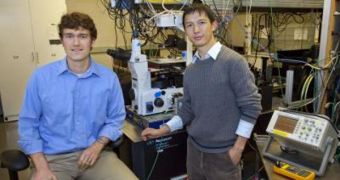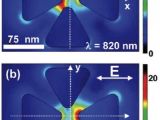Scientists at the US Department of Energy's (DOE) Lawrence Berkeley National Laboratory (Berkeley Lab) have recently developed a new type of nanostructures that is extremely efficient in capturing, filtering and steering light at the nanoscale. The group, based at the Berkeley Lab Molecular Foundry, says that the new achievement bears considerable implications for new generations of color-sensitive filters and detectors.
The small, bowtie-shaped antennas have proven to be highly effective in focusing and sorting light in very tiny spaces, in essence acting like “nano-colorsorters,” as the team calls them. At this point, fiber optics still represent the main method of transporting light at high bandwidths, but problems begin to emerge as soon as the light beam is focused into narrow spaces. The diffraction limit then kicks in. In short, the limit refers to the universal constraint that photons cannot be crammed into a space that is smaller than half their wavelength. A 450-nanometer beam cannot be crammed in a space smaller than 225 nanometers, or at least so it was believed until recently.
“Like the antenna on your TV or radio, optical nanoantennas efficiently catch and concentrate energy, but the wavelengths are much smaller. We've made the first engineered and nanofabricated structure for nanoscale light distribution that can ship and manipulate ultra-confined optical information with a knob you can easily tune – the energy or color of light,” Jim Schuck says.
He is an expert in the Imaging and Manipulation of Nanostructures Facility at the Molecular Foundry, an institution that provides world-class nanoscience research opportunities for scientists around the world. In order to combine the high bandwidth of optical fibers with the ability to manufacture devices at the nanoscale, a technology termed “plasmonics” was recently developed, which combines the best of optical and electronic communications.
“We can now control the plasmonic properties of these devices by introducing asymmetry, and we find red and blue light is literally sent left and right. By pushing the limits of manipulating light in a smaller volume, we can move information to one place or another quickly and efficiently, which is important for fast, color-sensitive photodetection,” Zhaoyu Zhang, a post-doctoral researcher at the Molecular Foundry, adds. “Our findings lend insight into the link between simple symmetry breaking and the coherent coupling properties of localized plasmons, providing a pathway for engineering intricate devices that can control light in extremely confined spaces,” Schuck concludes.

 14 DAY TRIAL //
14 DAY TRIAL // 
